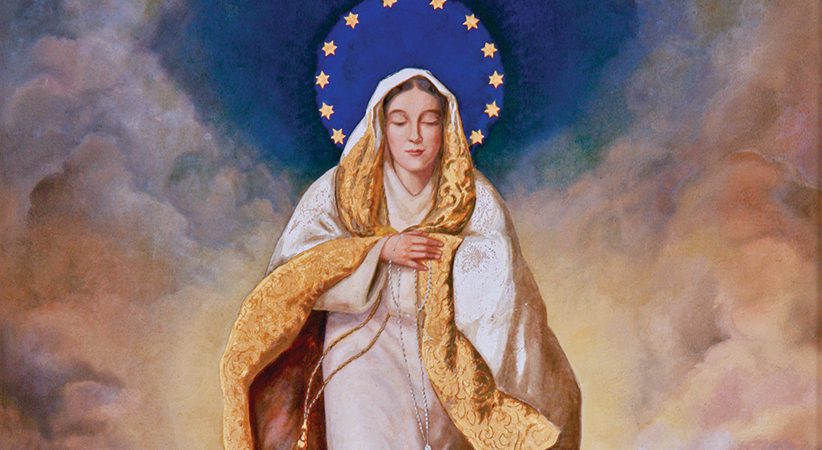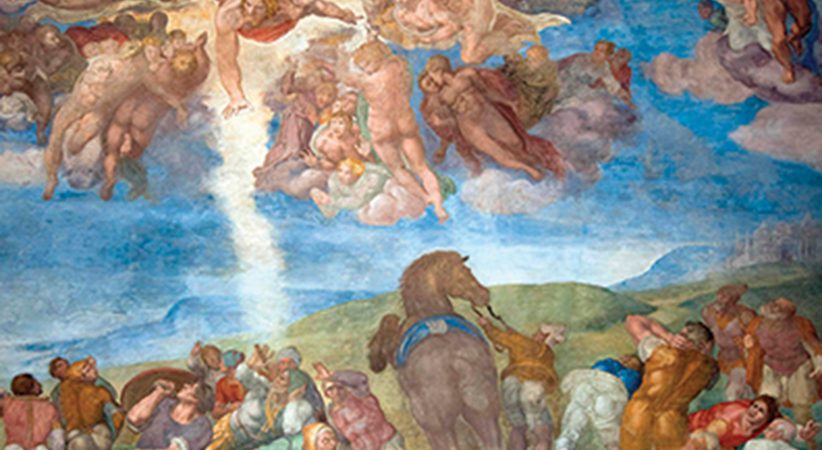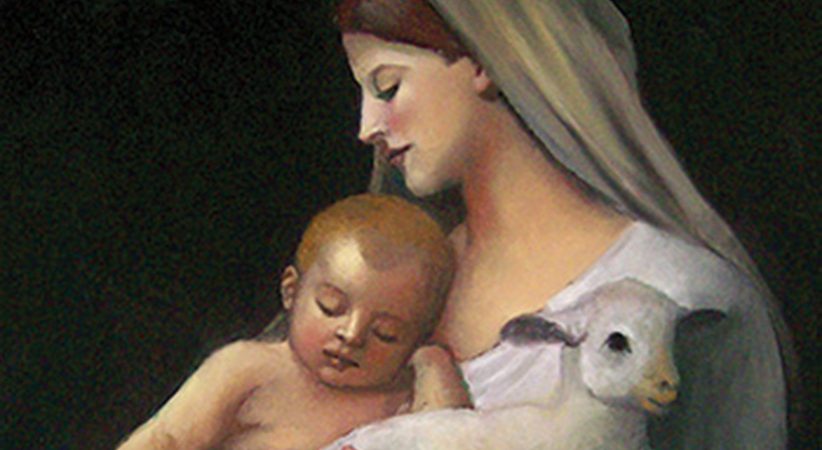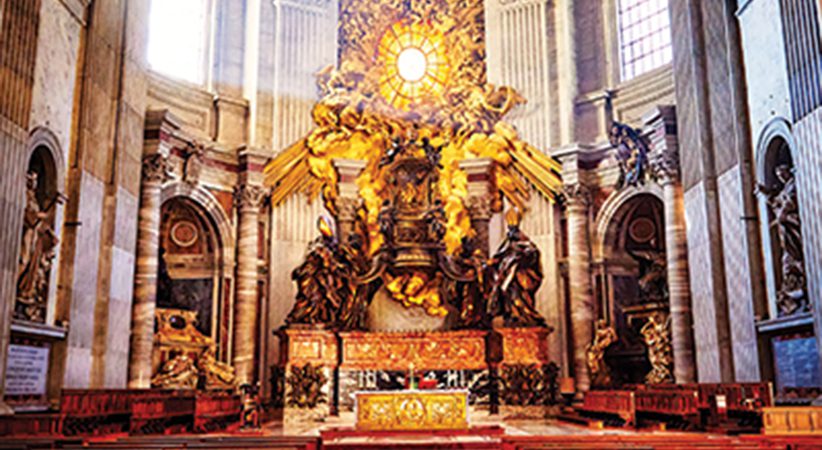The Fátima Prayer and Christian Hope
‘Decade prayer’ reminds us of the reality of hell, need for humility
Robert Fastiggi Comments Off on The Fátima Prayer and Christian Hope
The celebration last year of the 100th anniversary of the apparitions at Fátima brought the topics of heaven, hell and God’s mercy into new focus. The Church, following sacred Scripture, teaches that God “wills everyone to be saved and come to the knowledge of the truth” (1 Tm 2:4; see Lumen Gentium, No. 16). This truth of God’s universal salvific will, however, must be balanced with what Pope St. John Paul II called the “real possibility” of damnation (general audience, July 28, 1999). He added, however, that the possibility of damnation “is not attributed to God’s initiative because in his merciful love he can only desire the salvation of the beings he created.” Those who are damned freely close themselves off from God’s love and mercy, and God simply ratifies their freely chosen separation.
During her appearance to the three shepherd children on July 13, 1917, the Blessed Mother revealed a three-part secret. The first part was a frightening vision of hell. After seeing this horrible sight, the children looked up, and Our Lady spoke to them “so kindly and so sadly”: “You have seen hell where the souls of poor sinners go. To save them, God wishes to establish in the world devotion to my Immaculate Heart. If what I say to you is done, many souls will be saved and there will be peace.”
The Blessed Mother then taught the children this prayer: “O my Jesus, forgive us our sins, save us from the fires of hell. Lead all souls to heaven, especially those in most need of thy mercy.” This prayer is often called the “decade prayer” because it is frequently recited at the end of each decade of the Rosary. It is a prayer, though, that can be recited at other times of the day outside of the recitation of the Rosary.
Prayers of the Angel
This prayer, known as the Fátima Prayer, highlights one of the central themes of Fátima: God’s mercy and his desire for the conversion and salvation of poor sinners. This theme is found even in the prayers taught to the children by the Angel of Peace (or Portugal) who appeared to them three times in 1916. In the first of these angelic apparitions, in the spring of 1916, the angel taught the children this prayer: “My God, I believe, I adore, I hope, and I love thee! I beg pardon for those who do not believe, do not adore, do not hope, and do not love thee.”
In the third of the angelic apparitions, in the autumn of 1916, the angel gives holy Communion to the three children and teaches them this prayer: “Most Holy Trinity — Father, Son and Holy Spirit — I adore thee profoundly. I offer thee the most precious body, blood, soul and divinity of Jesus Christ, present in all the tabernacles of the world, in reparation for the outrages, sacrileges and indifferences whereby he is offended. And through the infinite merits of his most Sacred Heart and the Immaculate Heart of Mary, I beg of thee the conversion of poor sinners.”
This prayer is concerned with the “conversion” of poor sinners, but it teaches us to rely not just on our own prayers, but the Eucharistic offering of Christ and the infinite merits of the Sacred Heart of Jesus and the Immaculate Heart of Mary. In many ways this prayer resembles the prayer recited at the beginning of each decade of the Divine Mercy chaplet: “Eternal Father, I offer you the body and blood, soul and divinity of your dearly beloved Son, Our Lord Jesus Christ, in atonement for our sins and those of the whole world.”
Seeking Salvation
The vision of hell shown to the three shepherd children — two of them now canonized saints — elicits a response of prayer and concern for the salvation of poor sinners. There is no sense of the children feeling that the souls in hell are simply getting what they deserve. The response of the children instead is one of love and concern for the salvation of poor sinners.
Yes, the first part of the “Rosary decade prayer” manifests a concern for our own salvation — “O my Jesus, forgive us our sins, save us from the fires of hell” — but this immediately is followed by a concern for the salvation of all others: “Lead all souls to heaven, especially those in most need of thy mercy.” The message of Fátima, therefore, is both individual and communal. We must ask forgiveness for our own sins, but we also must pray for the conversion of all sinners, because, again, “God wills everyone to be saved and come to the knowledge of the truth” (1 Tm 2:4).
A Sacrificial Prayer
The communal aspect of the “decade prayer” also is expressed in another prayer taught by the Blessed Mother on July 13, 1917. This “sacrifice prayer” is meant to accompany sacrifices offered for the conversion of sinners. Our Lady told the children: “Sacrifice yourself for sinners, and say many times, whenever you make any sacrifice, ‘O Jesus, it is for love of you, for the conversion of poor sinners and in reparation for the sins committed against the Immaculate Heart of Mary.’” All three of the children took this message to heart, and when Sts. Francisco and Jacinta were suffering terribly before their deaths in 1919 and 1920, they offered up their afflictions for the conversion of poor sinners.
| Power of the Rosary |
|---|
|
”There is no problem, I tell
you, no matter how difficult it is, that we cannot resolve by the prayer of the holy Rosary.” — Sister Lucia dos Santos, one of |
Offering sacrifices for the conversion of sinners is a major theme of Fátima, and it goes back to a question the Blessed Mother asked the children during her apparition of May 13, 1917: “Are you willing to offer yourselves to God and to bear all the sufferings he wills to send you as an act of reparation for the sins by which he is offended and of supplication for the conversion of sinners?”
The message of Fátima invites us to join our prayers and sacrifices to the passion of Christ offered “in atonement for our sins and those of the whole world.” Priests are called to make present the Eucharistic sacrifice of Christ. The lay faithful, as members of Christ’s body, can, in their own way, join in this offering, and they also can unite their sufferings to the sacrifice of Christ “in reparation for the outrages, sacrileges and indifferences whereby he is offended.” The faithful can draw upon the infinite merits of Our Lord’s Most Sacred Heart and the Immaculate Heart of Mary to beg the conversion of poor sinners. Our Lady of Fátima also made a special appeal to the children to pray the Rosary daily for peace in the world and the conversion of sinners.
Reflections on Fátima
The vision of hell shown to the children on July 13, 1917, and the “decade prayer” highlight a number of important Catholic doctrines: the reality of hell; God’s desire for the salvation of all; and our need to pray for the conversion of poor sinners, especially those in most need of God’s mercy.
| Pope Francis on Our Lady of Fatima |
|---|
|
“Our Lady foretold, and warned us about, a way of life
that is godless and indeed profanes God in his creatures. Such a life — frequently proposed and imposed —risks leading to hell. Mary came to remind us that God’s light dwells within us and protects us. … According to the belief and experience of many pilgrims, if not of all, Fátima is more than anything this mantle of Light that protects us, here as in almost no other place on earth. We need but take refuge under the protection of the Virgin Mary and to ask her, as the Salve Regina teaches: ‘show unto us … Jesus.’” — Homily on May 13, 2017, during the canonization Mass |
In her July 13, 1917, apparition, Our Lady predicted the coming of many afflictions, saying: “The good will be martyred, the Holy Father will have much to suffer, various nations will be annihilated. In the end, my Immaculate Heart will triumph.”
In his 2000 commentary as prefect of the Congregation for the Doctrine of the Faith, Cardinal Joseph Ratzinger explained the meaning of the triumph of Mary’s Immaculate Heart: “The heart open to God … is stronger than guns and weapons of every kind. The fiat of Mary, the word of her heart, has changed the history of the world, because it brought the Savior into the world — because, thanks to her ‘yes,’ God could become man in our world and remains so for all time. The Evil One has power in this world, as we see and experience continually; he has power because our freedom continually lets itself be led away from God. But since God himself took a human heart and has thus steered human freedom toward what is good, the freedom to choose evil no longer has the last word.”
Faith and Hope
The message of Fátima is both prophetic and eschatological. We can never lose hope, because we trust in the triumph of good over evil. This is why the Blessed Mother asked the children to pray to Jesus “to lead all souls to heaven, especially those in most need of thy mercy.”
There has been much discussion about the 1986 book by the Swiss theologian Hans Urs von Balthasar “Was Dürfen Wir Hoffen?” which was published in English in 1988 under the title “Dare We Hope: ‘That All Men Be Saved.’” Balthasar never claimed that salvation for all is a fact, but he did believe that there is an obligation to hope for the salvation of all. We don’t need to enter into the debate as to whether or not Balthasar’s position is sound or convincing. It is enough to note what the Catechism of the Catholic Church teaches: “In hope, the Church prays for ‘all men to be saved’” (No. 1821), and “the Church prays that no one should be lost” (No. 1058).
|
Like what you’re reading? Subscribe now.
|
The possibility of hell is real, but for those still living there is always hope for conversion and salvation. The “decade prayer” of Fátima reminds us of our obligation to pray that “no one should be lost.” Because of God’s universal salvific will, there is always hope for even the worst of sinners. They are the ones “most in need” of God’s mercy, and we should pray and sacrifice for their salvation.
ROBERT FASTIGGI, Ph.D., is a professor of systematic theology at Sacred Heart Major Seminary in Detroit. He is former president of the Mariological Society of America.





